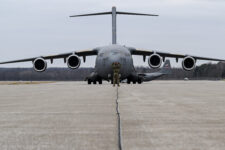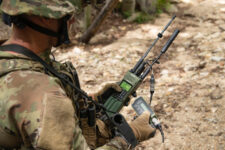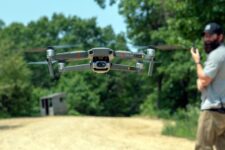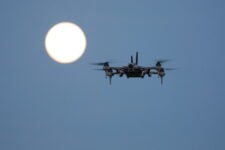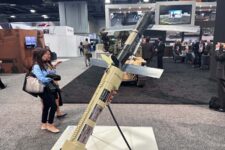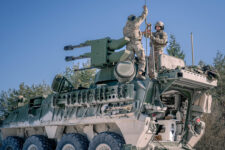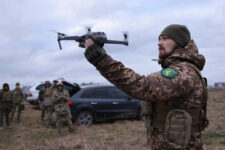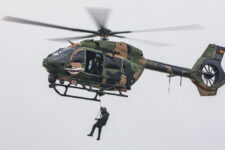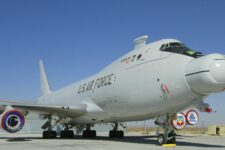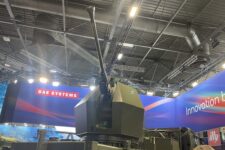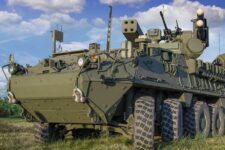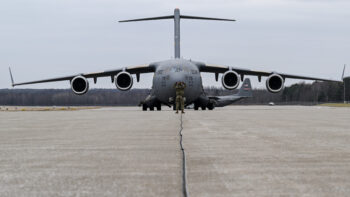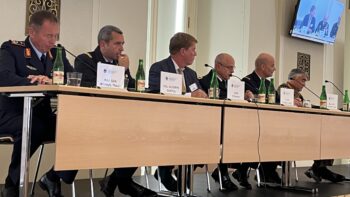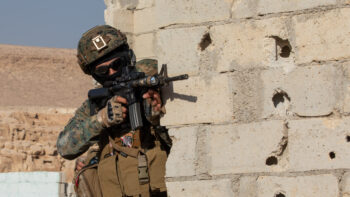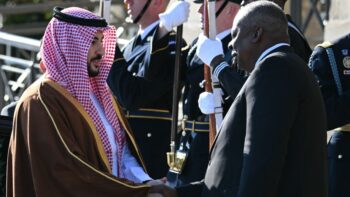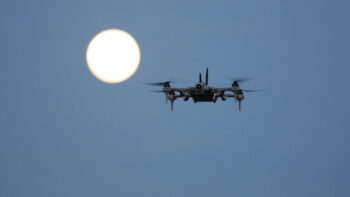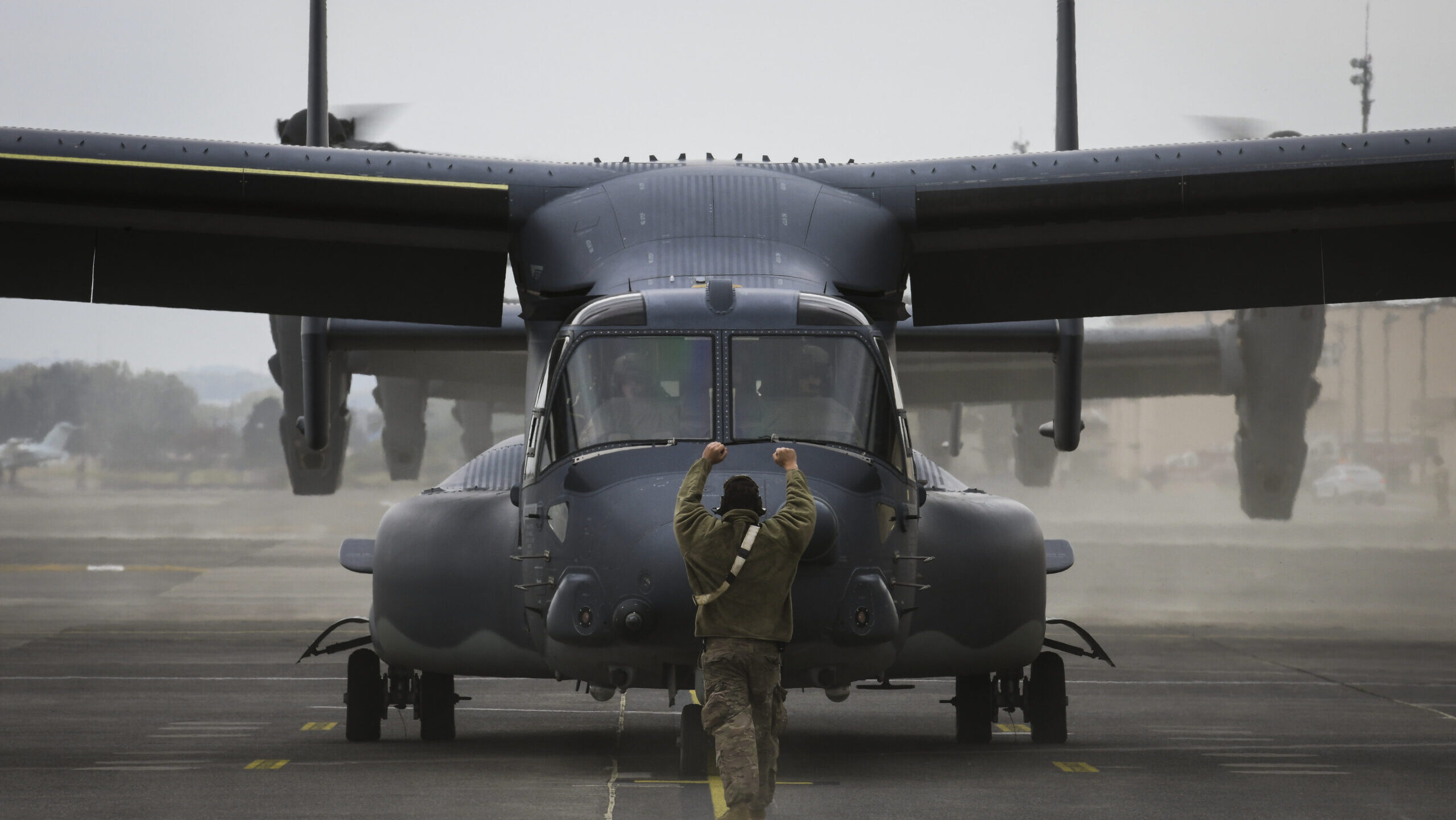
Four CV-22 Osprey tiltrotor aircraft assigned to the 353rd Special Operations Group Detachment 1 fly above Tokyo, Japan, April 5, 2018. (U.S. Air Force photo by Senior Airman Joseph Pick)
YOKOTA AIR BASE, Japan — Six months after a tragic V-22 Osprey crash off the coast of Japan resulted in the deaths of eight US Air Force special operators, the surviving members of the 21st Special Operations Squadron are getting back to work ahead of a return to flight sometime this year.
The Pentagon in March greenlit a plan that would allow the Air Force, Navy and Marine Corps to slowly restart V-22 flight operations, paving the way for the Osprey to return to the skies following the Nov. 29 mishap and subsequent grounding.
The 21st Special Operations Squadron (SOS) located at Yokota Air Base, Japan — which was home to six of the airmen killed in the crash — has yet to restart CV-22 flights, and there is no exact timetable to do so, 21st SOS Commander Lt. Col. Matt Davis told Breaking Defense in his first interview since the November mishap.
However, a group of six members from both the 21st SOS and the 753rd Special Operations Aircraft Maintenance Squadron (SOAMXS), which maintains the five CV-22 Ospreys assigned to the unit, stressed to Breaking Defense that they are ready to see the CV-22 back in action and have no concerns about the safety of the aircraft.
“They’re confident in the decision making from our higher headquarters and the Joint Program Office,” said Lt. Col. Eric Cranford, commander of the 753th SOAMXS. Those leaders “are looking at 750,000 flight hours of history and making data driven decisions. That gives me, as a commander, comfort in our technical order changes to, say, do ‘XYZ’ instead of ‘ABC.’”
While the Navy and Marine Corps have been quick to restart V-22 flight operations, flying shortly after the return to flight criteria was announced, the Air Force has moved more slowly. As of May 29, several Ospreys at Cannon Air Force Base in New Mexico have begun flying operations focusing on rebuilding crew currency in the aircraft, Air Force Special Operations Command (AFSOC) spokesperson Lt. Col. Rebecca Heyse told Breaking Defense. Japanese and US Marine Corps V-22s resumed flight operations in Japan in March.
US military officials from AFSOC, the service’s contingent that operates its CV-22 variant, and the V-22 Joint Program Office have not disclosed the exact course of action units will take to return the Osprey to flight. However, in March, AFSOC Commander Lt. Gen. Tony Bauernfeind laid out the basics of a three-pronged approach that starts with ground simulator training, integrating new safety controls and protocols and reviewing maintenance records. (Bauernfeind has since been tapped to lead the Air Force Academy.)
The second phase involves a “multi-month program” for aircrews and maintainers to regain “basic mission currency,” before moving to the final phase where operations will be fully resumed, Bauernfeind said.
RELATED: Pentagon clears V-22 Osprey to fly again
For the two squadrons at Yokota, some of that work has already started. The 21st SOS is running its ground-based V-22 simulator twice a day, five times per week, with aircrews moving through a “pretty rigorous program” focused on emergency procedures, Davis said.
Meanwhile, the maintainers of the 753rd are using the time that would normally be spent fixing aircraft to add training tasks during phased inspections of the CV-22s, an in-depth analysis of the tiltrotor that occurs after a scheduled period of time. For instance, maintainers — especially the new members of the squadron, who joined in recent months — will pull out and re-install different parts in order to practice skills they would normally be doing as part of their job.
“Just like any other specialty, there’s going to be some muscle atrophy,” Cranford said, adding that when the 21st restarts flight operations, it will be his job to ensure that his airmen can keep up with the maintenance demands of the aircraft and to advocate for more maintenance time between flights, if needed.
“That’s really what it’s going to be, is taking it day by day, doing the temperature check and making sure our folks are in the right headspace,” he said.
Both Davis and Cranford were careful not to put a timeline on any future activities associated with the CV-22 return to flight, noting that their priority is to ensure that aircrew and maintainers feel confident and mentally resilient enough to restart operations.
“Emotions come in different waves,” Davis said. “It’s a very personal experience — loss, grief and everything goes along with that. So that aspect of return-to-fly has been a central focus for all of us.”
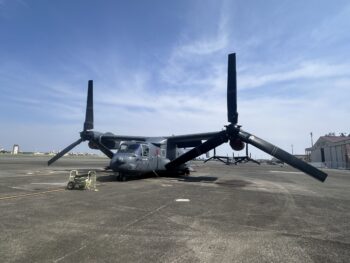
A line of CV-22 Ospreys on display at Yokota Air Base, Japan on May 24, 2024. (Valerie Insinna/Breaking Defense)
But aircrew and maintainers are showing signs that they’re eager to get back to work. For instance, Davis said pilots are fighting over the opportunity to do low-rung tasks typically performed by squadron members with little seniority, such as ground runs, where a pilot starts up an aircraft to allow maintainers to check the performance of its engines and systems.
“It’s our vocation to go fly this thing,” Davis said. “I jumped on a ground run the other day just so I could go turn rotors and fire everything up and see the screens queued up.”
Davis wasn’t the only one who expressed excitement about the return to flight.
“People want to come back and work on this thing,” said Tech Sgt. Richard Bassett, a CV-22 flightline expediter with the 753rd. “Maybe not because the aircraft is super easy, and every day is super awesome, but because the people here are super awesome.”
For the two squadrons, the next major milestone is a functional check flight: a short, basic flight where the V-22 will take off and fly close to the base. Davis said he had already called dibs on piloting that first sortie, but wasn’t willing to estimate when it would occur.
“It’s going to happen when it happens,” he said.
‘Color was coming back’
For the 21st SOS, the ongoing road back to restart CV-22 operations has been uniquely difficult.
The special operations community at Yokota is small, and members of the 21st and 753rd repeatedly stressed that both squadrons are especially close-knit, in part because they are geographically separated from the rest of the 353rd Special Operations Wing, which is based at Kadena Air Base in Okinawa.
Many members of the two squadrons have built years-long friendships with the airmen who were killed, leaving them to deal with the grief of losing brothers-in-arms in the wake of the November crash.
“Most everybody joins special ops because we want to do things, we want to be the one who helps. The hardest thing for some of us was to seek help for a little bit,” Davis said. “The trick was, like, obviously utilizing everything that was made available to us and understanding that not being okay for a short period of time is okay. Just don’t stay like that.”
In the dark weeks following the mishap, members of the 21st and 753rd recalled receiving an outpouring of support. Mental health resources, which included an operational psychologist specially trained to treat servicemembers who have undergone trauma, along with a mental health team from Cannon Air Force Base, were made available on a 24/7 basis.
RELATED: V-22 Osprey operating with limited envelope, required to stay near airfields
Chaplains and first sergeants — who ensure leaders are aware of issues impacting the morale of a unit and advocate on behalf of personnel — offered counseling and other assistance to airmen who needed help, and military spouses from other units brought in home-cooked lunches on an almost daily basis, members of the 21st and 753rd recalled.
There was no pressure from above to get back to work, and airmen were given the space to grieve in their own way, Cranford and Davis said. Some airmen played cards to relax, others held conversations in small groups, while others wanted to keep as busy as possible.
“I had airmen within two, three days of the incident coming to me and saying ‘Sir, can I just [go to work]? That’s my therapy. Can I just go tinker?’ You know what, if that’s your therapy, you do you,” he said. “One guy, I gave him my chief’s office, and he painted for nine hours and came out with a phenomenal memorial painting.”
By the third week, the shadow surrounding the squadrons had started to lift, with people finally able to laugh at shared memories of the airmen who died in the accident, members from the two squadrons said.
“It was kind of like, color was coming back to our organization,” said Senior Master Sgt. Jesse Heckart, the 21st SOS senior enlisted leader.
A Return To Flight
AFSOC has not revealed the root cause of the November crash, which is still under investigation. Officials have acknowledged a component failure occurred on the CV-22 involved in the accident, but have not ruled out other potential factors that may have contributed to the mishap.
“We have high confidence that we understand what component failed, and how it failed. I think what we are still working on is the why and so that is still in the hands of the investigation,” Marine Corps Col. Brian Taylor, the program manager in the Pentagon’s V-22 Joint Program Office, told reporters in March.
The investigation is currently in its “final stages” and will be publicly released after the aircrew’s families have been briefed, Heyse, the AFSOC spokesperson. AFSOC declined to provide further comment on the component that failed. (It is possible more information will come out during a House Oversight Committee hearing on V-22 safety scheduled for June 12.)
Outside the base, questions about the safety record of the Osprey remain prevalent among the Japanese public.
Demonstrations where protesters carried “NO OSPREY” signs proliferated after the November crash and, after the Pentagon announced the restart of V-22 operations, Japanese newspapers questioned whether the return to flight occurred too soon. (At a happy hour in Tokyo in mid-May, one Japanese journalist asked this reporter whether the Osprey was truly safe, expressing his own doubts.)
The residents of Fussa — the city that borders Yokota’s main gate — “are concerned for the safety since there has not been been sufficient explanation provided on the cause of the accident and the measures to be taken,” a spokesman for the city’s base affairs division told Stars and Stripes in May.
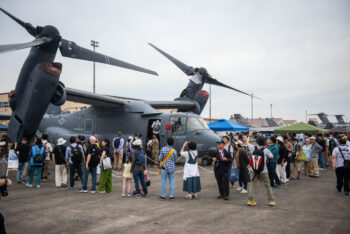
A line of community members wait to view a static display CV-22 Osprey assigned to the 353rd Special Operations Wing, Kadena Air Base, during the 2024 Japanese-American Friendship Festival at Yokota Air Base, Japan, May 19, 2024. (U.S. Air Force photo by Staff Sgt. Tristan Truesdell)
Davis said the 21st SOS and 753rd SOAMXS aren’t fazed by the outside political drama, pointing to the crowd of Japanese aviation enthusiasts who crowded around the V-22 during Yokota’s annual Friendship Festival held on May 19, showering pilots and maintainers with requests for photos.
What would he say to members of the public who point to V-22 accidents throughout its history and say that the Osprey is too dangerous to fly?
At this question, Davis tells a story: In late 2018, he was deployed to Yokota to help stand up the 21st SOS, which formally came online in 2019. One morning, he was sitting at the Dunkin Donuts eating breakfast when he saw on the news that an F/A-18 had collided with the KC-130J refueling it during a mission off the coast of Japan.
Within two hours, Davis was flying to Iwakuni on a CV-22 tasked with locating the downed aircrew of the two planes — the same type of search and rescue mission that would occur five years later to find the fallen members of the 21st SOS.
“We searched almost literally night and day for 14 days at distances that nothing else airborne could go,” he said. “That’s important. When it comes down to it, we can do things that others can’t.”
